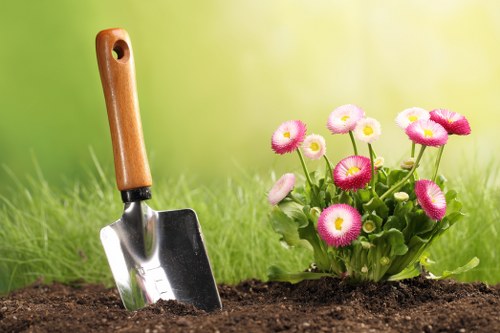Mastering Garden Maintenance: The Art of Hedge Trimming

Maintaining a beautiful garden requires a combination of knowledge, skill, and regular care. One of the essential aspects of garden maintenance is hedge trimming. Properly trimmed hedges not only enhance the aesthetic appeal of your garden but also promote the health and longevity of your plants.
Hedge trimming involves the careful cutting and shaping of hedges to maintain their desired form and size. Whether you have a formal garden with neatly manicured hedges or a more naturalistic landscape, regular trimming is crucial to achieving and maintaining the look you desire.
In this comprehensive guide, we will explore the various aspects of hedge trimming, including the best practices, tools needed, and seasonal considerations. By the end of this article, you’ll have a thorough understanding of how to keep your hedges in pristine condition year-round.
Why Hedge Trimming is Essential

Hedge trimming is not just about aesthetics; it plays a vital role in the overall health of your plants. Regular trimming helps to:
- Promote healthy growth: Trimming removes dead or diseased branches, allowing the hedge to focus its energy on healthy growth.
- Maintain shape and size: Keeping your hedges trimmed ensures they remain the desired height and shape, preventing them from becoming overgrown.
- Improve air circulation: Properly trimmed hedges allow for better air movement, reducing the risk of fungal diseases and pests.
- Enhance sunlight exposure: Trimming opens up the canopy, allowing more sunlight to penetrate and nourish the plants.
By understanding the importance of hedge trimming, you can better appreciate the effort required to maintain a thriving garden.
Choosing the Right Tools for Hedge Trimming

Having the appropriate tools is essential for effective hedge trimming. The right equipment ensures that you can achieve clean cuts and maintain the health of your hedges without causing unnecessary stress to the plants.
Here are some of the essential tools you’ll need:
- Pruning Shears: Ideal for small branches and precise trimming. Choose a pair with sharp blades and comfortable handles.
- Hedge Trimmers: Available in manual and electric versions, hedge trimmers are perfect for shaping and cutting larger areas quickly.
- Loppers: These are great for thicker branches that pruning shears can’t handle.
- Protective Gear: Always wear gloves and safety goggles to protect yourself from debris and sharp tools.
- Post-Trimming Tools: Consider using a broom or leaf blower to clean up debris after trimming.
Investing in high-quality tools will not only make the job easier but also ensure that your hedges remain healthy and well-shaped.
Manual vs. Electric Hedge Trimmers

When selecting hedge trimmers, you have the option of choosing between manual and electric models. Each type has its advantages and is suitable for different types of gardens and trimming needs.
Manual Hedge Trimmers: These are hand-operated and do not require electricity or batteries. They are lightweight, quiet, and environmentally friendly. Manual trimmers are best suited for smaller hedges and precise, detailed work.
- Pros:
- Eco-friendly
- Lightweight and easy to maneuver
- Less maintenance
- Cons:
- Requires more physical effort
- Slower for large areas
Electric Hedge Trimmers: These are powered by electricity or batteries, making them more efficient for larger hedges and extended trimming sessions. Electric trimmers offer greater cutting power and speed but can be heavier and noisier compared to manual ones.
- Pros:
- Higher cutting efficiency
- Suitable for larger hedges
- Less physical effort required
- Cons:
- Requires power source
- Heavier and bulkier
- May require regular maintenance
Steps for Effective Hedge Trimming

Executing hedge trimming correctly ensures the health and appearance of your hedges. Follow these steps for effective trimming:
- Assess the Hedge: Before you begin, inspect the hedge for any dead or diseased branches and remove them first.
- Choose the Right Time: The best time for hedge trimming is during the growing season, typically in late spring or early summer. Avoid trimming during extreme weather conditions.
- Plan the Shape: Decide on the shape you want for your hedge, whether it's formal and straight or more natural and flowing.
- Start Trimming: Begin by trimming the sides of the hedge, working from the bottom up to ensure an even shape. Use sweeping motions for a uniform appearance.
- Top the Hedge: After the sides are trimmed, focus on the top to achieve the desired height and contour.
- Clean Up: Remove all trimmings and debris from the area to maintain a tidy garden space.
- Inspect and Adjust: Check for any uneven areas and make necessary adjustments to ensure symmetry.
By following these steps, you can maintain a well-groomed hedge that enhances the beauty of your garden.
Seasonal Hedge Trimming Tips

Different seasons require different approaches to hedge trimming. Understanding the seasonal needs of your hedges ensures they remain healthy and vibrant throughout the year.
- Spring: This is the ideal time for a major trim, encouraging new growth and shaping the hedge before the growing season begins.
- Summer: Light trimming helps maintain the shape and remove any dead or damaged branches caused by harsh weather.
- Autumn: An autumn trim prepares the hedge for winter, removing any weak or fragile growth that could be damaged by cold temperatures.
- Winter: Generally, avoid trimming during winter unless necessary. If you must, ensure the hedge is dormant to minimize stress.
Adapting your trimming practices to each season helps your hedges thrive and stay aesthetically pleasing year-round.
Tools Maintenance for Longevity

Proper maintenance of your hedge trimming tools extends their lifespan and ensures consistent performance. Here are some maintenance tips:
- **Clean After Use:** Remove any plant residue and debris from your tools after each use to prevent rust and buildup.
- **Sharpen Blades:** Regularly sharpen the blades of your pruning shears and hedge trimmers to ensure clean cuts and reduce plant stress.
- **Lubricate Moving Parts:** Apply lubricant to hinges and moving parts to keep them functioning smoothly.
- **Store Properly:** Store your tools in a dry, protected area to prevent damage from the elements.
- **Inspect Regularly:** Check for any signs of wear or damage and repair or replace parts as needed.
Maintaining your tools not only makes your hedge trimming more efficient but also contributes to the overall health of your garden.
Common Hedge Trimming Mistakes to Avoid

Even with the best intentions, it's easy to make mistakes when trimming hedges. Being aware of common pitfalls can help you avoid them and achieve better results:
- Trimming Too Much: Removing too much foliage can stress the plant and affect its growth. Aim to trim no more than one-third of the hedge at a time.
- Ignoring Plant Type: Different hedges have unique growth patterns and trimming needs. Research your specific hedge type before trimming.
- Using Dull Tools: Dull blades can cause jagged cuts, leading to disease and poor growth. Keep your tools sharp.
- Inconsistent Trimming: Irregular trimming can result in an uneven appearance. Strive for consistency in shape and size.
- Neglecting Seasonal Care: Failing to adjust your trimming practices for different seasons can harm your hedges. Follow seasonal trimming guidelines.
By avoiding these common mistakes, you can maintain healthy and attractive hedges with ease.
Choosing the Right Hedge for Your Garden

Selecting the appropriate hedge type is crucial for both maintenance and aesthetic purposes. Consider factors such as growth rate, height, climate suitability, and visual appeal when choosing hedges for your garden.
- Boxwood: A popular choice for formal gardens, boxwood is dense, evergreen, and easy to shape, making it ideal for structured hedges.
- Privet: Known for its rapid growth and flexibility, privet is excellent for creating tall, thick hedges quickly.
- Yew: Yews are slow-growing but highly durable, with rich green foliage that remains attractive throughout the year.
- Laurel: Laurel hedges are robust and can handle heavy trimming, making them suitable for high privacy barriers.
- Beech: Beech hedges offer vibrant autumn colors and a dense structure, adding seasonal interest to your garden.
Choosing the right hedge type ensures that your garden not only looks beautiful but is also manageable in terms of maintenance.
Eco-Friendly Hedge Trimming Practices

Incorporating eco-friendly practices into your hedge trimming routine benefits both your garden and the environment. Here are some sustainable approaches:
- Use Electric Tools: Opt for electric or battery-powered hedge trimmers to reduce carbon emissions compared to gasoline-powered models.
- Recycle Trimmings: Compost your hedge clippings or use them as mulch to enrich your garden soil naturally.
- Choose Manual Tools: For smaller hedges, manual tools are energy-efficient and produce zero emissions.
- Selective Trimming: Trim only what is necessary to maintain plant health, minimizing waste and preserving natural growth cycles.
- Water Conservation: Properly trimmed hedges require less water, contributing to overall water conservation in your garden.
Embracing eco-friendly hedge trimming practices aligns your garden maintenance with sustainable living, promoting a healthier environment.
Advanced Techniques for Hedge Shaping

For gardeners looking to take their hedge trimming skills to the next level, advanced shaping techniques can create stunning visual effects and enhance the overall design of your garden.
Some advanced techniques include:
- Topiary: This art form involves shaping hedges into intricate and decorative forms, such as animals, geometric shapes, or abstract designs.
- Layered Trimming: Creating layers within your hedge adds depth and dimension, making it a focal point in the garden landscape.
- Contouring: Shaping your hedge to follow the natural contours of your garden adds harmony and balance to the overall design.
- Color Varieties: Mixing different types of hedges with varying leaf colors and textures can create a dynamic and visually appealing display.
By mastering these advanced techniques, you can transform ordinary hedges into captivating garden features that showcase your creativity and expertise.
Incorporating Lighting into Trimmed Hedges

Enhancing your trimmed hedges with garden lighting can add a magical touch to your outdoor space, making it more inviting and visually striking during the evening hours.
- Pathway Lights: Install lights along pathways bordered by trimmed hedges to guide guests and highlight the garden structure.
- Spotlights: Use spotlights to accentuate the shape and form of your hedges, creating dramatic shadows and highlights.
- String Lights: Draping string lights through trimmed hedges adds a festive and whimsical ambiance to your garden.
- Solar-Powered Lights: Opt for solar-powered options for an eco-friendly and cost-effective lighting solution.
- LED Strips: Conceal LED strips within the tips of trimmed hedges for subtle yet effective illumination.
Integrating lighting into your hedge trimming not only enhances the beauty of your garden but also extends its usability into the nighttime.
Hiring Professional Hedge Trimming Services

While DIY hedge trimming can be rewarding, hiring professional garden maintenance services can offer several advantages, especially for larger or more complex gardens.
- Expertise: Professional gardeners have the knowledge and experience to trim hedges precisely and healthily.
- Time-Saving: Outsourcing hedge trimming frees up your time to enjoy other aspects of garden care or personal activities.
- Proper Tools: Professionals come equipped with specialized tools that ensure efficient and effective trimming.
- Consistent Maintenance: Regular professional maintenance ensures your hedges stay in optimal condition year-round.
- Health Assessments: Experts can identify and address potential health issues in your hedges, preventing long-term damage.
If you prefer a hands-off approach or have extensive hedges that require meticulous care, consider hiring a professional garden maintenance service for hedge trimming.
Cost Considerations for Professional Services

Understanding the cost factors associated with professional hedge trimming can help you make an informed decision about outsourcing this task.
- Size of the Hedge: Larger hedges require more time and effort, increasing the overall cost.
- Height and Complexity: Taller or more intricately shaped hedges may necessitate specialized equipment or additional labor.
- Frequency of Trimming: Regular maintenance contracts might offer discounted rates compared to one-time services.
- Geographical Location: Costs can vary based on your region and the availability of professional services.
- Additional Services: Services such as cleanup, disposal of trimmings, or plant health assessments can influence the total cost.
Evaluate these factors and obtain quotes from multiple providers to ensure you receive fair pricing for professional hedge trimming services.
Conclusion: Achieving Garden Excellence Through Hedge Trimming

Hedge trimming is a fundamental component of garden maintenance that contributes significantly to the beauty and health of your outdoor space. By understanding the importance of regular trimming, selecting the right tools, and employing effective techniques, you can ensure your hedges remain a stunning focal point in your garden.
Whether you choose to undertake hedge trimming yourself or enlist the help of professionals, the effort invested will yield rewarding results. A well-maintained hedge not only enhances curb appeal but also provides functional benefits such as privacy, wind protection, and habitat for beneficial wildlife.
Embrace the art of hedge trimming as part of your garden maintenance routine, and enjoy the enduring beauty and vitality it brings to your landscape.
Contact us today to learn more about our professional garden maintenance services and let us help you achieve the garden of your dreams.